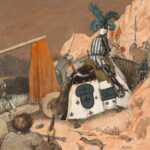Albert Lynch
Biography
Albert Lynch (26 September 1860 – 25 March 1950) was a painter of Peruvian descent, born in Germany but who spent his entire life in France, where he is considered a French artist. He was the son of Diego Lynch, from a Peruvian family, and Adele Bertha Emma Koeffler, from a German family; his maternal grandfather was the landscape painter Thomas Koeffler. Conflicting sources report his birthplace as either Lima or Gleisweiler in the Rhineland, and some suggest that Lynch may have emphasized a Peruvian origin to avoid anti-German sentiment in France following the Franco-Prussian War of 1870. However, archival records indicate that he was baptized in Gleisweiler.
Lynch grew up and worked entirely in France, primarily in Paris, where he studied at the École des Beaux-Arts under William Bouguereau, and later trained in the ateliers of Jules Noël, Gabriel Ferrer, and Henri Lehmann. He adopted French nationality and, in October 1896, married Maria Anna Victoria Bacouel.
Lynch was a regular exhibitor at the Salon des Artistes Français, earning recognition in 1890 and 1892, and was awarded a gold medal at the 1900 Exposition Universelle. He specialized in portraits of women and genre scenes reflecting French life, often favoring tempera, pastel, and watercolor over oil painting. His work embodies the elegance and vibrancy of the Belle Époque, yet many of his pieces reveal a subtle undercurrent of romantic melancholy. Lynch also illustrated several widely acclaimed literary works, including Alexandre Dumas fils’ La Dame aux Camélias, Honoré de Balzac’s Le Père Goriot, and Henry Becque’s La Parisienne.
In 1930, Lynch relocated to the Principality of Monaco, residing on Avenue de la Gare (now Avenue Prince Pierre) until his death in 1950 at the age of ninety. His legacy remains defined by his delicate portrayal of women, his mastery of pastel and watercolor, and his contribution to the visual culture of fin-de-siècle France.

